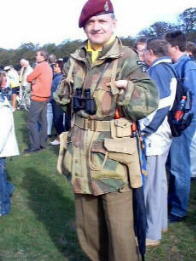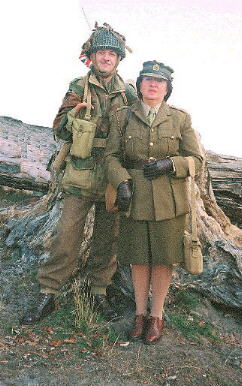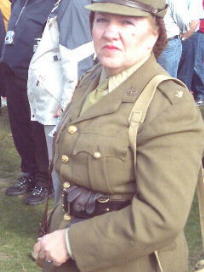Military Wireless Museum
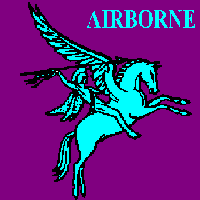
ARNHEM
A Bridge just too far
A holiday trip to Holland some years ago found me on the road towards the mid Dutch/German boarder. On the signposts were displayed the towns of Oosterbeek and Arnhem, names that rang bells in my military memories.

A Map of the battle area, the bridge on the right, the drop zones on the left and Osterbeek in the center.
It will probably be hard to find anyone who has not heard of Arnhem, or if so, then they know the film of the episode called "A Bridge Too Far". But it is likely that many of those who have heard of the place have never been there.
There is little to distinguish Arnhem today. a couple of old church's, one rather large, the odd old building, but most of the town around the famous bridge has long gone and been replaced with 50's, 60's concrete monster blocks. Oosterbeek survives better. Many old buildings, small streets, little period houses that were there long before its war time event. Outside Oosterbeek stands the cemetery were those who fell in that eventful action have been laid to rest. The grounds are meticulously tended, the grass cut, the flowers pruned and the headstone glean white in the sun.
There are numerous memorials around the bridge area in Arnhem, at the bridge itself, and in the streets below where some of the fiercest fighting took place. The bridge there today is a new one, the bridge fought for in 1944 was bombed in 1945 and replaced with the present day structure. Its shape and style however, are of the period.
At Oosterbeek is the museum to the Airborne forces, located in the very building, then the Hotel Hartenstein, used as the HQ during the last stand by the British troops. To some, their interest in military wireless is only monetary, but to others, the actual usage and role of such sets is deeply interesting. Radio played an important role at Arnhem, perhaps more so by its failure than by its success.

A picture taken at the time ............................................... and one 52 years later !
Walking around the museum at Oosterbeek, one of the dioramas in the basement depicts the typical signals set up. Wireless sets such as No 18, 19 set and amplifier, 22, 38, 46, 62 and 76 set can be seen along with the R109 which was used in conjunction with the 76 set sender. I do not say each set was definitely used during the battle, only that they are shown in the museum.
American sets are on display including the BC-611 walkie-talkie and the BC-1000A back pack. A number of German sets are displayed along with much weaponry and uniforms of the period. I am lucky enough to have an Arnhem vet living in the same town, one Ray Corneby, who was with the 2 Bn South Staffs. Dropping in on the second day, Ray never reached the bridge but spent the time fighting in and around Oosterbeek. Electing to remain firing whilst the others slipped over the river meant that, despite evasive actions afterwards, he was taken by the Germans the next day. Sent to a prison camp on the Eastern boarder of Germany he, along with many other's, were force marched West as the Russian troops advanced in the East. Finally, near Frankfurt, he was relieved by the US troops in March 45. I am indebted to Ray for his conversations.
 Signals problems
Signals problems
Wireless communications at Arnhem were affected for several reasons. The sets had been tuned up and netted in England and had be loaded then unloaded from aircraft a number of times as various operations were on then cancelled.
Then, on the actual operation, the sets were dropped from the aircraft with the troops or landed with the glider force. All this banging around obviously affected those settings. As Lieutenant Colonel John Frost, after whom the bridge is now known, put it "I made my way to the rendezvous to meet my battalion HQ where immediately I became aware of how badly the wireless were working. A lot of them had been packed away for some time, in anticipation of an operation, and they'd been netted for the terrain of Lincolnshire, which was open country. But as we left the dropping zone we were soon into heavily wooded country and soon into built up areas as well, so they did not work at all well." (Ref 1)
Colonel Frost also stated "On arrival, sometimes with a hefty crump, which puts the wireless set off net, its understandable that they didn't work. This meant that all commanders had great difficulty exercising command." (Ref 2) Brigadier Lathbury stated in his diary "Meanwhile we heard from the Brigade Major on the wireless that the 2nd Bn had captured the bridge. Splendid. After that all wireless communication broke down" (Ref 3)
Major Ian Toler, a glider pilot, recalls a vivid scene "It was a dramatic scene, windows full of bullet holes, one chap bent over a wireless and a single candle burning. The atmosphere was very tense, they'd had terrible communication problems but had just managed to get through to 2nd Bn holding the bridge." (Ref 4)
Major Tony Hibbert recalls that on reaching the bridge "We set up command in a house 50 yards from John Frost's position and took over the attic as it was the only place our wireless might work. There were six or seven of them and the place soon became rather conspicuous with aerials sticking out of every window and tile hole" (Ref 5)
Major Hibbert continues "My first job was to inform Division that we held the bridge. Not one of our wirelesses could pick up the faintest whisper from anyone in Northern Europe except John Frost who was all of 50 yards away.". At one point during the battle on the north side of the bridge a Private James Sims recalls that the Lieutenant in the OP "was shouting down fire orders, since the walkie-talkies were not working, and Joe couldn't understand why he could hear the orders when he knew he wasn't hearing them through the set". (Ref 6)
It must be remembered that many of the military sets used at the time (but not at Arnhem) were of extremely low transmit power. The 38 set for instance is 250mW, that's only a quarter of a watt. Certainly QRP operators will say that this can reach to the otherside of the world, but, not when fed into an 8 ft whip, half poking out of a tiled roof top. The Wireless set No 18 is also very low power output. Indeed, even the mighty 46 set, with its 1 watt output, when fed to a short whip is very limited in range. Added to that the problem of netting these sets, though the 46 set is crystal controlled, and the difficulties experiences can well be imagined.
Note: see paragraph Februrary 2005 below.
The distance problem
The museum shows the 76 set sender and the R109. Presumably these were being used to try and establish communication with the main force, 30 Corps, who were all of 11 miles away at Nijmegan. Again, the limiting feature was probably the aerial. I assume lengths of wire were passed out from the cellar positions and held as high as possible outside. Indeed, the distances involved was a great problem to the forces. Major Tony Deane-Drummond, second in command of the Divisional signals, states "At Div HQ we were worried, even on the first afternoon; we were having trouble with our wireless sets which were only designed to carry signals up to three miles and it was eight miles to the bridge." (Ref 7)
The signposts at Wolfhez railway crossroads showing the 9Km to Arnhem,

Failure in ground to air communications meant re supply drops went straight into enemy hands. Also, lack of fighter air support did a lot to heighten the misery of the ground troops. There are a couple of pages on the communication situation as related in Christopher Hibberts book 'The Battle For Arnhem'. For instance "Most disastrous of all, as the ground to air VHF sets were very heavy and would have needed extra gliders to carry them, the only means of signalling for close air support was by two Veeps (jeeps with VHF trans-receivers and crystal controlled SCR-193) transmitting on a special comms network". Ref 8. He goes on to further reveal that General Urquhart stated in his official report that "Signals need drastic revision and improvement. The sets are not satisfactory and the range attributed was always grossly exaggerated". Brigadier Hicks, who took over temporary command of the Division, had his difficulties increased by the fact that there were still virtually no wireless links working satisfactorily on the second day.
Br. Hicks comments "Our comms back to base in England were weak and erratic and being constantly interfered with by a strong German station. We had no communications direct to Corps HQ although messages could be sent via England. We had lost touch with 1st Parachute Brigade HQ when they were only 5 miles away from our HQ in spite of every on our part to improve the position of our Divisional HQ sets.". Ref 9.
Further summing up accounts of the signals problem appear at the end of Hibberts book, a note from Major-General Moberly, Chief Signals Officer 1st Airborne, comments on the poor performance of sets and notes the selection of the WS No22 as the main set for air landings. Ref 10.
From the horses mouth, so to speak
I have been in contact with several participants of this adventure. For example, a signaller who was at the bridge, Eric Chrystal and his 22 set were set up in building at the bridge and as Eric wrote, "from the start reception was bad to put it mildly, during the 4 days I was there I cannot recall ever getting through to the gun positions or 30 Corps.".
Regimental Signaller Ron Graydon, arriving with an 18 set (probably a 68 set though.. ed), only recalls one contact from the 19th till the 26th. Jimmy Little also arrived with an 18 set (again, probably a 68 set..ed) on the 18th, but after the landing the set was u/s and no contacts were made. Later, joining a 19 set HP unit, Jimmy searched for the armour net but without luck.
NEW ITEM: (2000)
I have just spent an enjoyable weekend with an Arnhem vet, not any old vet but one who actually made it to bridge, then back to the main force then back across the river. As a Sgt in a mortar plt he did not use radio but recalls seeing them and of course, talking about their failure at the time.
To make it to the bridge was a feat in itself. To then evade capture and rejoin the main force back at Oosterbeek was a feat above and beyond. To then get back across the river must set this man apart. Indeed, later action saw this man awarded the MM. That weekend was one of the best of my life. To be in the presence of such a man simply showed me what dull lives we do lead. We all think ourselfs important and that the jobs we do are so great. How would we fair faced with the same ordeal this man went through. I raise my hat in honour.
New New Item (2002)
I have just returned from attending the 2002 commemorations, great event, lots of old friends seen and many new ones made. The stamina of these chaps puts me to shame. I really must get down the gym more.
 Right: Myself with Wireless set No 18 on Ginkle Heath 2002, the dropzone for the first troops into Arnhem. It was great to have so many vet's come up and chat about their times there.
Right: Myself with Wireless set No 18 on Ginkle Heath 2002, the dropzone for the first troops into Arnhem. It was great to have so many vet's come up and chat about their times there.
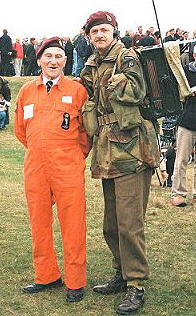 Left: Myself with good friend Jimmy Little, Royal signals. Still jumping around !.
Left: Myself with good friend Jimmy Little, Royal signals. Still jumping around !.
And finally
Obviously, as a pure outsider, not having been there, it is impossible to say what really happened. But I feel sure that its evident from the different accounts that the signals failure played a great part in the mess encountered. Whether it was a failure in the radio sets themselves, or as Lewis Golden OBE suggests in his book "Echoes From Arnhem", Ref 11, a failure to understand the limitations of the radios, that is the question.
Lewis goes on to suggest that the radio nets were misunderstood by
certain participants, that communications between certain groups were
never envisaged or set up and that certain commanders took the lack
of communication to be radio failure, rather than the error in
organisation that it was.
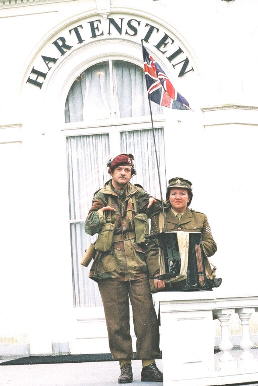 (left)Royal Signals, A.T.S. and Wireless set 18 at the site of history.
(left)Royal Signals, A.T.S. and Wireless set 18 at the site of history.
I have up to this point not mentioned the most well known book on Arnhem, A Bridge Too Far by Cornelius Ryan from which a very good film was made ( mainly because I have only just got around to reading it, July 2003). Interesting points in this book, things might have been a lot different if: the commander had not been away from control of things for so long, if more attention had been given to securing the heights to the west of Oosterbeek which gave excellent views of the river below the church, had more been accepted from the underground, indeed, apparently there were even those who wanted to join in the fighting at the bridge which may have helped.
Hindsight is a wonderful thing but were these things that should have been done on the day ?
In any respect, as a collector and user of these sets there is a difference between what the signallers had to do then and the playing with these sets today. Its easy to work great distances today, old set to modern ham set, using high, long wires etc. But how easy it was to get a message 8 miles down the road, with a bent bit of 8 ft whip held amongst trees, between buildings, under constant fire, who knows ?
Its evident from these few accounts that a great deal of effort and pain was put in and suffered by those young signallers back in 1944. After reading more on the subject I know I will never look at these sets with the same feelings. For who knows, one of us might well have that actual set that was just not good enough back in 44. The restoration and operation of these sets takes on a whole new meaning for those of us not simply driven by money. Operations such as Arnhem, and there are many, many more that can be recounted, show an insight into military communications that cannot be underestimated.
And finally, with regard to the radio side of things, we should spend some time and think more of the poor souls who's lives depended upon these sets.
2003 visit:
Had the wonderful opportunity to go inside No 14 Zwarteweg, the house where
General Urquhart hid out for two days. This is the corner between Alexander
Straat on the left and Zwarteweg on the right.
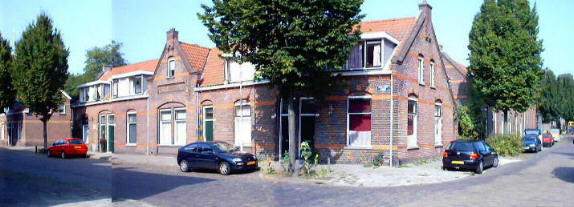
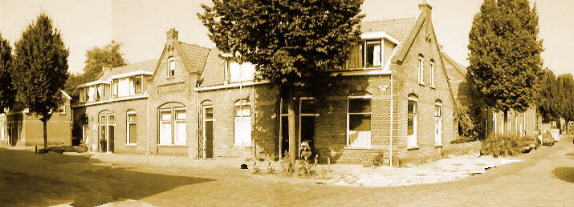
.............................................................................................................................Now as it looked in 1944 maybe


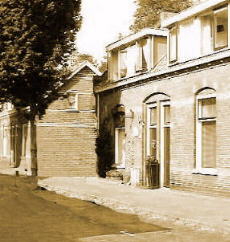
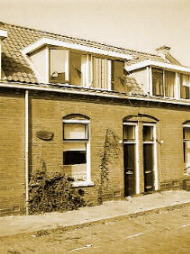
No 135 (left, corner house by red car) is where the shot Lathbury was carried into and where General U shot the
German through the window. No 14 (right, by another red car) is where the General and Captains Taylor and Cleminson
hid out in the attic while a German SP gun sat in the street where the red car is sat.
..........................................................................................................................1944 versions of the same scene .. maybe.
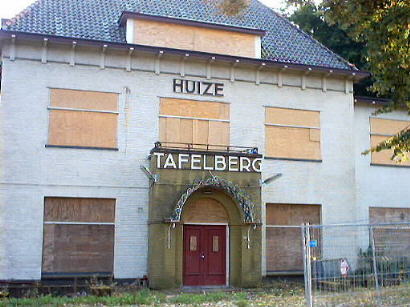 The appauling state of Hotel Tafelberg now. This was a first aid post on the edge of the
Oosterbeek fighting area and many men who died of their wounds were buried in the
hotels front garden. Its a real shame the council could not see fit to make this a more
respectable monument.
The appauling state of Hotel Tafelberg now. This was a first aid post on the edge of the
Oosterbeek fighting area and many men who died of their wounds were buried in the
hotels front garden. Its a real shame the council could not see fit to make this a more
respectable monument.
2004 visit: 60 Years on.
Another great visit, many friends met and new ones made. Delighted to meet Lewis
Golden in person.
The two of use awaiting the arrival of the drop on the heath on the Saturday morning, great
weather for it.
On the heath afterwards, the crowds are gone and one can be alone with one's thoughts.
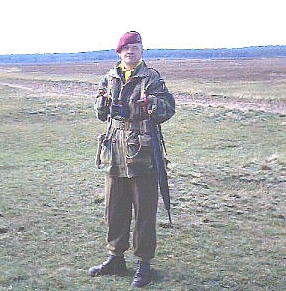
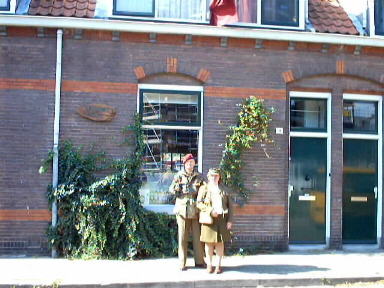
And after, a further visit to Zwartewg and Urquhart House
Visited the railway culvert where the Recce Sqd caught fire when racing for the bridge
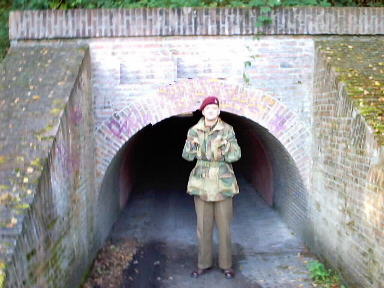
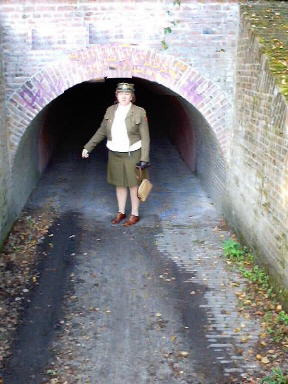
You can see just how low it is but still enough height to get a jeep through with the window screen
down
February 2005.
I have just finished reading a most interesting book, "Red Berets & Red Crosses" by N Cherry. A most informative book dealing with the medical services in the 1st Airborne Div with particular coverage of the medics actions in Arnhem.
It was really fascinating to read this version of the Arnhem action, one from a non fighting point of view but which contains some really harrowing and dreadful accounts of the hardships suffered by these men.
Of particular interest is that it is the first book read that actually mentions the use of the local telephone network to get information between British troops. Considering the communication problems the fighting troops had its amazing more use of the telephone was not made but there are at least two references, page 90 and 91, to this being used by the medics to find out what was going on.
I think this book is a must read for all interested parties.
My deepest thanks to letters received from: ERIC CHRYSTAL, HARRY HOWLETT, AUSTIN BREARTON, FRANK NEWHOUSE, K E LITTLE, RON GRAYDON, GEORGE DIXON, ALLAN WESTALL, G W JUKES, STUART BOYD, VIC READ, LEO HALL.
References:
1: Men Of The Red Beret, Max Arthur, p195.
2: Victory In Europe, IWM, Julian Thompson, p158.
3: As Ref 2, p157.
4: As Ref 1, p191.
5: As Ref 1, p202.
6: As Ref 1, p214.
7: As Ref 1, p234.
8: The Battle of Arnhem, Christopher Hibbert, p96-97.
9: As Ref 8, p95. 10: As ref 8, p205.
11: Echoes From Arnhem, Lewis Golden OBE.
Send an e-mail to: Ben Nock, G4BXD
(If link does not work on your PC then send email to: [email protected] )
********* Pictures by G4BXD are G4BXD copyright ********




 Signals problems
Signals problems

 Right: Myself with Wireless set No 18 on Ginkle Heath 2002, the dropzone for the first troops into Arnhem. It was great to have so many vet's come up and chat about their times there.
Right: Myself with Wireless set No 18 on Ginkle Heath 2002, the dropzone for the first troops into Arnhem. It was great to have so many vet's come up and chat about their times there.
 Left: Myself with good friend Jimmy Little, Royal signals. Still jumping around !.
Left: Myself with good friend Jimmy Little, Royal signals. Still jumping around !.
 (left)Royal Signals, A.T.S. and Wireless set 18 at the site of history.
(left)Royal Signals, A.T.S. and Wireless set 18 at the site of history.






 The appauling state of Hotel Tafelberg now. This was a first aid post on the edge of the
Oosterbeek fighting area and many men who died of their wounds were buried in the
hotels front garden. Its a real shame the council could not see fit to make this a more
respectable monument.
The appauling state of Hotel Tafelberg now. This was a first aid post on the edge of the
Oosterbeek fighting area and many men who died of their wounds were buried in the
hotels front garden. Its a real shame the council could not see fit to make this a more
respectable monument.
